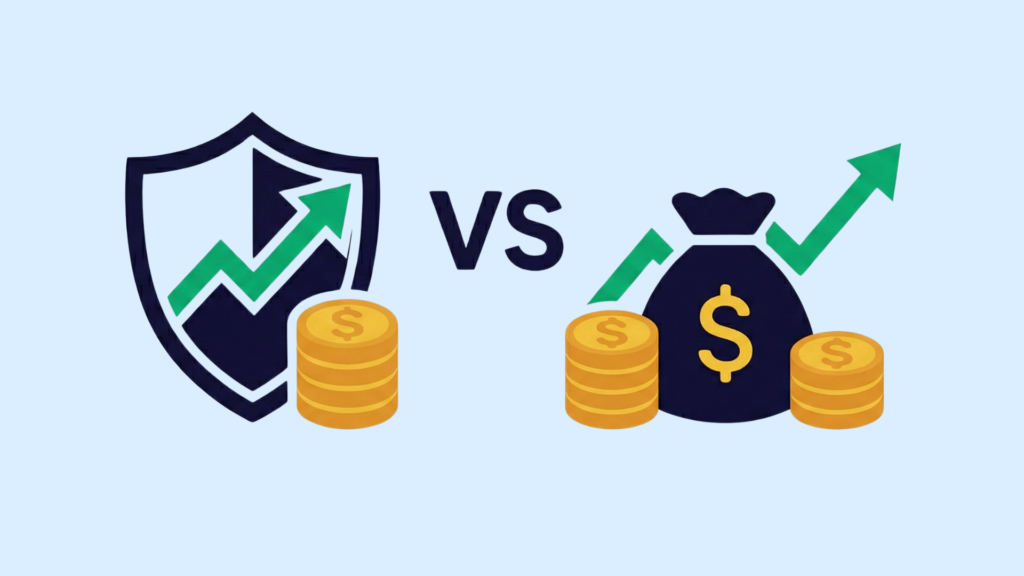Hybrid mutual funds blend equity and debt investments to deliver a unique investment experience. By combining these asset classes, they offer the potential for growth while providing a degree of income stability, making them an appealing choice for many investors.
Whether you’re a conservative investor looking for stability or an aggressive one seeking growth, hybrid funds can perfectly fit your needs. Read along to learn more about hybrid mutual funds!
What are Hybrid Mutual Funds?
Hybrid mutual funds are investment schemes that combine multiple asset classes, primarily a mix of equity (stocks) and debt (bonds). This approach helps you pursue growth and income while distributing risk across different investments.
Investing in hybrid funds offers a diversified strategy that can stabilise your portfolio. By spreading your investments across various asset classes, you can lower the effect of market volatility and better manage your risk.
Key Features of Hybrid Mutual Funds
Understanding the key features of hybrid mutual funds can help you make informed investment decisions. Here’s what you should know:
Diversification Across Asset Classes
Hybrid funds invest in equity and debt securities, which helps mitigate risk while aiming for better returns over time. This combination allows you to benefit from the potential growth of stocks and the stability of bonds.
Balanced Risk and Reward
These funds offer a mix of high-growth equity assets and stable debt securities, creating a balance that suits many investors. This balance allows you to pursue higher returns without taking on excessive risk.
Suitable for Various Investor Profiles
Hybrid mutual funds cater to various investors, from conservative to aggressive. Depending on the equity-to-debt ratio in the fund’s portfolio, you can find a fund that aligns with your risk tolerance and investment goals.
Ideal for Medium-Term Goals
If you’re looking for investments with a 3-5-year horizon, hybrid funds are a strong choice. They provide a suitable option for those aiming to meet medium-term financial objectives while maintaining a balanced risk profile
Also Read: Equity Mutual Funds | Mutual Funds vs ETFs | Closed Ended Mutual Funds
Types of Hybrid Mutual Funds
Now, let’s look at the different types of mutual funds to help you choose the right hybrid mutual fund that aligns with your financial goals and risk tolerance.
Based on Asset Allocation
Hybrid mutual funds vary in their approach to balancing equity and debt investments. Here are the main types:
Aggressive Hybrid Funds
Aggressive hybrid funds invest 75-80% of their assets in equities, with the remainder in debt instruments. These funds suit investors with a higher risk appetite who seek significant growth potential.
Conservative Hybrid Funds
Conservative hybrid funds allocate 25-35% of their assets to equities and invest most in debt instruments. These funds are designed for risk-averse investors looking for capital protection along with some growth.
Balanced Hybrid Funds
Balanced hybrid funds maintain an equal allocation of 50% in equities and 50% in debt. This structure offers a moderate risk-return profile, making it suitable for investors who want a balanced approach to investing without taking on excessive risk.
Equity-Oriented Hybrid Funds
Equity-oriented hybrid funds invest at least 65% in equities, with the remainder in debt. They are taxed as equity funds, which can benefit tax efficiency. These funds are ideal for investors seeking equity-like returns while having some protection against market volatility.
Debt-Oriented Hybrid Funds
Debt-oriented hybrid funds allocate at least 60% to debt instruments, with a smaller portion in equities. They are primarily focused on providing steady income, making them suitable for conservative investors who prioritise income generation over aggressive growth.
Multi-Asset Allocation Funds
Multi-asset allocation funds invest across various asset classes, including equity, debt, and sometimes gold or international securities. This approach offers further diversification, which can help manage risk while providing growth opportunities.
How Hybrid Mutual Funds Work
Hybrid mutual funds strategically allocate equity and debt assets to achieve growth and income. Fund managers determine this allocation based on market conditions to balance the potential for capital appreciation with the stability of debt investments.
Additionally, during market uptrends, the fund’s equity portion aims to generate higher returns, benefiting from rising stock prices. Conversely, the debt portion acts as a stabilising force during downturns, helping to protect your investment from significant losses.
Fund managers continually adjust the asset allocation to optimise returns, ensuring that your investment remains aligned with prevailing market trends.
Benefits of Investing in Hybrid Mutual Funds
Understanding the benefits of hybrid mutual funds can help you see why they are a valuable addition to your investment portfolio. Here are the key advantages:
Diversification
Hybrid funds provide diversification by spreading investments across different asset classes. This reduces the risk of losses from any single investment and creates a balanced risk profile.
Potential for Capital Growth
With a significant equity component, hybrid funds offer the potential for capital appreciation over time. This helps you grow your wealth while benefiting from the stability of the debt portion.
Income Stability
The debt investments within hybrid funds provide regular income and stability, making these funds less volatile than pure equity funds. This can be especially beneficial during uncertain market conditions.
Flexibility in Asset Allocation
Hybrid funds allow flexibility as fund managers can adjust the equity-to-debt ratio based on changing market conditions. This ensures you can pursue optimal returns in both rising and falling markets.
Tax Benefits
Equity-oriented hybrid funds’ gains are taxed at a lower rate than gains from traditional debt funds. This tax efficiency can lead to higher overall returns, which makes them an appealing option for investors.
Who Should Invest in Hybrid Mutual Funds?
Hybrid mutual funds cater to a diverse range of investors by offering a balanced investment approach. So, let’s look at who benefits most from these funds:
Conservative Investors
If you prioritise capital protection but want to gain more returns than fixed deposits offer, hybrid funds may be a good choice for you. They allow you to dip your toes into equity markets while maintaining a safety net through the debt component.
First-Time Equity Investors
For those new to investing, hybrid funds provide a manageable entry point into equity markets. You can experience potential market gains while the debt portion adds a layer of security.
Medium-Term Investors
If your investment horizon is 3-5 years, hybrid funds can be suitable. They balance risk and return, helping you reach your financial objectives without exposing you to excessive volatility.
Retirees Seeking Income and Growth
Retirees looking for a source of regular income, coupled with some growth potential, should consider hybrid funds. They offer a way to generate income while helping to outpace inflation through modest equity exposure.
How to Choose the Best Hybrid Mutual Fund
Selecting the right hybrid mutual fund is important for achieving your financial goals. Here are some practical tips to guide your decision-making process:
Assess Your Risk Appetite
Start by evaluating your risk tolerance. If you can handle higher volatility, aggressive hybrid funds with more equity exposure might suit you. Conservative hybrid funds with a larger debt component are better for those who prefer lower risk.
Evaluate the Equity-Debt Allocation
Look closely at the fund’s equity-debt allocation. If your goal is capital growth, consider funds with a higher equity percentage. On the other hand, if you prioritise stability and income, choose funds with a greater emphasis on debt.
Check Past Performance
Examine the fund’s historical performance across different market cycles. A fund consistently delivering returns during various market conditions can be a more reliable investment choice.
Consider Expense Ratio
Don’t overlook the expense ratio, which indicates the cost of managing the fund. Selecting funds with lower expense ratios can help maximise your net returns over time, ensuring that more of your money goes to work for you.
Taxation of Hybrid Mutual Funds
The taxation of capital gains on hybrid or balanced funds primarily depends on the equity exposure of the fund’s portfolio. If the equity exposure exceeds 65%, the fund is considered an equity mutual fund for tax purposes. Conversely, if the equity exposure is less than 65%, it is taxed according to the rules applicable to debt funds.
Equity-Oriented Hybrid Funds
For equity-oriented hybrid funds, which typically have more than 65% equity exposure, the taxation follows the rules for equity funds. This means:
- Short-Term Capital Gains (STCG): Gains from units held for less than one year are taxed at 15% plus applicable cess and surcharge.
- Long-Term Capital Gains (LTCG): Gains from units held for more than a year are taxed at 10% for gains exceeding Rs. 1 lakh, with no indexation benefit.
Debt-Oriented Hybrid Funds
For debt-oriented hybrid funds, where equity exposure is less than 65%, the taxation is similar to that of debt funds:
- Short-Term Capital Gains (STCG): Gains from units held for less than three years are added to the investor’s total income and taxed according to their applicable income tax slab rate.
- Long-Term Capital Gains (LTCG): Gains from units held for over three years are taxed at 20% with the benefit of indexation.
The Bottom Line
Hybrid mutual funds present a versatile investment option, blending equity and debt instruments to provide a balanced mix of growth and stability. They cater to investors looking for potential capital appreciation alongside reduced risk compared to pure equity funds.
Moreover, Appreciate offers a comprehensive platform to guide you through your investment journey in hybrid mutual funds. With personalised investment options, insightful analytics, and expert support, Appreciate helps you make informed decisions that match your financial objectives. Download the app now!
Hybrid Mutual Funds FAQs
What are hybrid mutual funds?
Hybrid mutual funds are investment vehicles that combine both equity and debt instruments to create a balanced portfolio. They aim to give investors the potential for capital appreciation and income generation through diversification.
How do hybrid mutual funds work?
Based on their investment strategy, hybrid mutual funds invest in a mix of stocks, bonds, and other securities. The fund manager actively allocates assets between equity and debt to achieve desired risk and return profiles.
What are the different types of hybrid mutual funds?
Several types of hybrid mutual funds exist, including aggressive hybrid funds, conservative hybrid funds, balanced advantage funds, and multi-asset funds. Each type varies in allocation between equity and debt, catering to different risk appetites.
Are hybrid mutual funds better than pure equity or debt funds?
Hybrid mutual funds can provide a balanced approach by mitigating risk while still offering growth potential, making them appealing to a wider range of investors. However, whether they are better than pure equity or debt funds depends on individual financial goals and risk tolerance.
How should I choose the best hybrid mutual fund?
To choose the best hybrid mutual fund, consider factors such as your investment objectives, risk tolerance, and the fund’s historical performance. Also, review the fund’s asset allocation strategy and management fees to ensure they align with your investment objectives.
What is the minimum investment period for hybrid mutual funds?
The minimum investment period for hybrid mutual funds typically varies by fund but is generally recommended to be at least three to five years. This time frame allows investors to ride out market fluctuations and benefit from potential long-term growth.
What are the tax implications of investing in hybrid mutual funds?
Investors in hybrid mutual funds face different tax implications. LTCG rates are 10% for equity and 20% for debt (with indexation), while STCG for equity is taxed at 15%, and debt profits are taxed as ordinary income.
Can hybrid mutual funds offer regular income?
Yes, hybrid mutual funds can offer regular income through dividends or interest distributions, depending on the fund’s structure and investment focus. However, the income generated may fluctuate based on market conditions and the performance of underlying assets.
Who should invest in hybrid mutual funds?
Investors looking for a blend of growth, income, and moderate risk exposure may find hybrid mutual funds suitable. They appeal to those who want to diversify their portfolios without committing to pure equity or debt funds.
What is the difference between aggressive and conservative hybrid funds?
Aggressive hybrid funds typically invest more of their assets in equities, aiming for higher returns with increased risk. In contrast, conservative hybrid funds focus more on fixed-income securities, providing lower returns with reduced volatility.
What is the risk level in hybrid mutual funds?
The risk level in hybrid mutual funds can vary based on asset allocation; aggressive funds carry higher risk due to increased equity exposure, while conservative funds are generally safer with more debt holdings. Overall, they offer a balanced approach to risk and reward.
How do hybrid mutual funds balance risk and reward?
Hybrid mutual funds balance risk and reward by diversifying investments across equity and debt. This allows them to benefit from stocks’ growth potential while reducing overall portfolio volatility through bonds.
Disclaimer: Investments in securities markets are subject to market risks. Read all the related documents carefully before investing. The securities quoted are exemplary and are not recommendatory.























